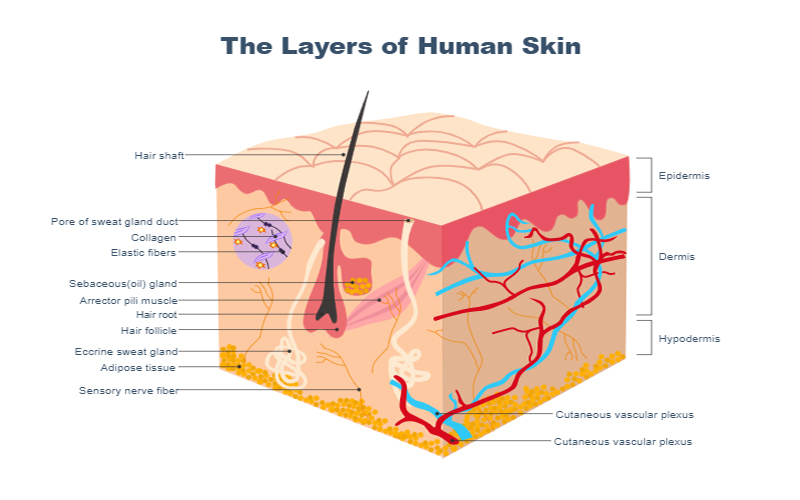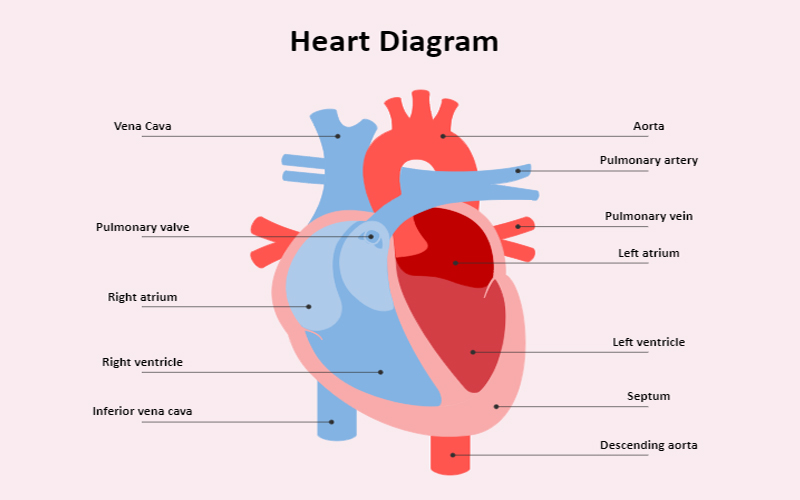What Is Biological Diagram
A biological diagram illustrates the structure of a specimen and describes the specific details about its different parts to explain its biological function. Here, you will learn everything you want to know about biological diagrams and how to create them. Check out our biology diagram templates and guide to make biology drawings.
1. What Is Biological Diagram?
The subject of biology deals with the study of organisms based on observations and descriptions, and we use biological diagrams to illustrate or document those observations. Its purpose is to describe the internal structure of specimens based on what they look like from the outside. With a biology drawing, instead of imagining what a specimen looks like internally, we draw its internal structure as opposed to its appearance. It helps the observer focus on the unique characteristics of the specimen instead of creating a simple mental image in their mind.
The biology diagram is an excellent learning tool for students who study biology because it helps them document their observation and use it later on for comparisons or research projects. Those who are related to the biology field know the importance of diagrams and drawings in the research and study of the subject. Diagrams act as a method of communication between the reader and the observer. It mirrors your observation in a visual representation of how you interpret anything.

Click on the image to edit. Source: EdrawMax Online
2. Benefits of Biological Diagram
Biological Diagrams Provide a Permanent record of your observations by documenting them in the form of illustrations. When it comes to biology, keeping a record of your descriptions and observations is essential because you might need them later or share them with others. A biological diagram is the best method of keeping records and aids memory.
Focus on every little detail of your observations with a biology diagram. When you create a biology drawing, you need to draw the specimen exactly how you observed it. Doing that helps improve your learning and makes examining the specimen a lot easier.
Construct a mechanistic description of any system or phenomenon with a biological diagram. These diagrams help in better explaining observations. Scientists use these diagrams to illustrate the internal structure of a specimen and conceptualize the reason behind the mechanics.
Provide details on various levels about the structure of your specimen with the help of biology drawings. The purpose of these diagrams is to describe or document your observation and explain them on various levels. You can use it only to describe the first internal layer, or you can focus on muscles or veins with these diagrams.
3. When to Use a Biological Diagram
Biological Functions: You can use a biological diagram to explain biological interactions or illustrate various functions. Functions are a specimen's traits, behavior, and morphological features in biology. With diagrams, you can describe every function with correct details and a visual representation.
Anatomy Demonstration: Biology drawings are most commonly used for anatomy demonstrations and learning purposes. Anatomy deals with the internal structure of a living organism that is hard to explain using narrative. With a biology diagram, scientists demonstrate the anatomy of any life form and explain its bodily structure.
Distinguish Species: Scientists use biological diagrams to depict the difference and comparison between species belonging to the same group or a single genus. With these diagrams, you can observe any species and study their internal structure to distinguish them from others. Adaptive radiation is one of its examples.
4. Guidance for Biology Drawing
You can create a biology drawing using two methods. The first one is the most commonly used method where you use diagramming software to make your diagram. The second one is the traditional method of drawing it with hands. Here are the general principles when drawing biology drawing manually.
- Use good quality and sharp pencils to draw clean lines and avoid using pencil colors.
- Make your diagram simple without any sketching, and make it big enough to at least cover 10 lines on the paper to illustrate the complete structure.
- Make sure your diagram is accurate and drawn in the middle of the page.
- Don't draw crowding parts in the diagram, and always use a heading or a caption.
- You can use a magnifying lens or glass to draw more detailed parts of your diagram accurately.
- Add neatly aligned labels, and make sure they do not cross each other.
5. How to Create a Biological Diagram
After understanding the layout and guidelines of the biology diagram, the next thing is to get a free template and get started with biology drawing software. EdrawMax Online is the best biological diagram maker that gives you free templates and many unique diagramming tools. It makes the process of creating biology drawing easy for you by helping you save time and effort. Here are the steps to create your diagram on EdrawMax Online.
- STEP 1: Log in to EdrawMax Online or create a new account.
- STEP 2: You can make your diagram using a template or open a blank canvas to draw it from scratch. Go to new, and click on the science and education category. Select biology and click on the "+" button to get a new canvas, or select a template to edit it right away.
- STEP 3: The next step is to customize your biological diagram. Go to the symbols library and insert icons and symbols with a simple drag and drop. Add connecters to visualize the relationship between components.
- STEP 4: After your diagram is complete, the next step is to download it. EdrawMax Online supports various document formats, so you can export in any format you want. You can also share and print it.
6. Checklists for Biology Graphs, Tables, and Drawings
For Graphs
- Check the size of the graph to determine whether the bits with actual plotted lines take half the page.
- Check for plotting and determine if all the data points are within half a little square of their required position.
- Check if a line or a curve represents the trend in your data.
- Check the axis to determine whether the independent variable is along the bottom and the dependent variable along the side.
- Is there any title?
- Are the names in each label using the right unit symbol?
For Tables
- Is the raw data in a single table with ruled borders and lines?
- Independent variable in the starting column; dependent variable in the right columns OR descriptive comments in columns to the right.
- Is the processed data in columns to the far right?
- There is no calculation, only calculated values in the table.
- Only the column heading got the units.
- Used multiple decimal places to record raw data.
- The same type of raw data is in similar decimal places.
- There is one more significant figure in processed data records than raw data.
For Diagrams
- Used a sharp pencil, and the lines are clear.
- The drawing takes up half the page.
- No shading or coloring in the diagram.
- The proportions are accurate relative to both sides of the diagram.
- The different areas are labeled for more details.
- The label lines don't cross each other.
- Label lines are touching the part you want to label.
- Include a scale and add concise notes.
- The diagram has a title to explain the specimen.
7. Biology Diagram Examples
To create a perfect biological diagram, check out a few examples and templates to get a better understating of its format. Here are some commonly used biology diagram examples with free templates that you can use to create your diagram. Pick the template you want and go to EdrawMax Online to customize and use it for your project.
Example 1: Biological Weathering Diagram
The biology weathering diagram in this example explains various weathering phenomena with easy-to-understand illustrations. This diagram describes how a rainbow forms after the sunlight gets reflected from the water in the air. Educators use these diagrams to teach students about the formation of rain clouds and the properties of the ozone layer.

Example 2: Protein Drawing Biology
This protein diagram biology example illustrates the process of DNA transformation. It is a process where DNA changes the cell's properties and clarifies the chemical nature of genes. Scientists use these diagrams to record their observations and share what they learned with their colleagues. The diagram is clean and easy to navigate. There are no crowded parts, and the labels align neatly.

Example 3: Biological Diagram of Human Body
You can use a biological diagram of the human body to examine and describe the bodily structure of humans, including their body parts and internal organs. These diagrams are mainly used to demonstrate anatomy. The diagram in this example illustrates the structure of a human heart. The diagram is clean with no extra parts or drawings. The labels connect to the part they are representing.

8. FAQ About Biological Diagram
1.How do you label a biological diagram?
Keep a few things in mind when labelling your biological diagram. Always use a sharp pencil and draw a straight label line. Label each part and detail of the specimen in your diagram. Don’t use arrows or draw a longer line. Make sure labels are not crossing each other and keep them aligned. Always write the label horizontally.
2.What makes a good biological diagram?
A good biological diagram conforms to all rules of biology drawing. Keep these five rules in mind to make a good biology diagram. Do not improvise and only add what you observed. Make your diagram simple and use an unlined sheet. Make a big diagram to avoid crowded parts and add clean and aligned labels.
3.What are the rules for biology drawings?
These are the rules for biology drawings.
- Use a sharp pencil to draw clean lines.
- Make your diagram simple without any sketching, and make it big enough to at least cover 10 lines on the paper to illustrate the complete structure.
- Make sure your diagram is in the middle of the page.
- Don't draw crowding parts in the diagram, and always use a heading.
- Make sure the labels are neatly aligned and do not cross each other.
9. Key Takeaways
A biological diagram illustrates the structure of any specimen and documents observations to provide a permanent record. It is an excellent learning tool that helps students with their projects and aids their memory. EdrawMax Online is the best biology drawing maker with many free templates and a symbol library with thousands of symbols and icons. It also supports various document formats and various customization tools. Go to EdrawMax Online and get started right away. You can easily create a spider map on EdrawMax Online. It gives you free professional templates and a symbol library to make your diagram. It also comes with unique customization tools and supports various document formats. Find more biology diagram examples.









